In Ireland, alcoholic beverages are as synonymous with the country as St. Patrick’s Day, four leaf clovers, magical leprechauns, legendary rock group U2 and famed poet W.B. Yeats. Ireland is also the home of director/writer/animator Thomas Quain, whose adult cartoon series Poxy Bleedin Shop is a brilliant brew of sharp-edged comedy and grounded observations of the many social problems that have long bedeviled the place nicknamed “The Emerald Isle”.
With season 1 of the series introducing audiences to the frequently weird and occasionally dangerous doings at a local off-license liquor shop, and with much of the storyline based on Quain’s past experiences working at such an establishment, season 2 of Poxy Bleedin Shop (now streaming its first of seven episodes on YouTube; first episode link below) emerges with more characters, better animation and an even bigger storyline to boot.
Though the eclectic personalities that travel in and out of the shop range from the wacky to the wicked, the issues they deal with – alcohol and drug abuse, the struggle to make ends meet, crime, homelessness – give them an exceptional level of depth that one might not instantly catch upon first watching Poxy Bleedin Shop. However, the show’s earnest look at those issues offers a remarkable counterpoint to the humorous incidents that take place in every episode.
Poxy Bleedin Shop’s titular off-license is run by Gary (voiced by series executive producer Aidan J. Collins), who finds himself under a high degree of pressure to get the place gushing with as much cash as it does suds. That job is made all the more tricky when Gary’s employer, the diabolical and reclusive Mr. Shadow (voiced by Quain) watches his every move.

Center: Gary (voiced by Aidan J. Collins) takes ownership of an off-license in season 2 of the adult comedy series POXY BLEEDIN SHOP, executive produced by Collins and created by Thomas Quain.
With nothing but profits in mind, Mr. Shadow has the perfect solution for getting Gary’s store in the black: selling a highly potent yet dirt-cheap vodka that quickly becomes a smash with customers. As time goes on, though, the vodka’s growing assemblage of drinkers experience some devastating side effects that make their inevitable hangovers even more painful…and more monstrous!
Even worse for Gary and his co-workers Thomas (also played by Quain) and Brian (Bernard Casey), the shop’s regular visitors aren’t exactly what you’d call “high class” connoisseurs of wine, beer and spirits. One of them is a notorious drug pusher/crocodile named Eddie (Owen Colgan), who along with his back alley henchmen Greg and Craig (both played by Colman Hayes) delights in terrorizing both his fellow citizens and the store’s easily intimidated staff.
Eddie’s long-suffering girlfriend/fellow street dweller Celine (Emma Doran) has had enough of living the destructive life she’s led for years, but struggles in her efforts to overcome the dual pains of her relationship and her past. Equally afflicted by personal strife is local care worker Emily (voiced by Valerie Ni Loinsigh). Though she tries to help alcoholics take their last sip, her biggest challenge is getting her stubborn and phone booth-bound father Liam (Karl Spain) to leave her alone.
Around the neighborhood, the only person who seems to care about Liam is a man known as much for his philanthropic activity as he is his way with a tune: U2 frontman Bono (spoofed effectively in Hayes’ performance). Unfortunately, the homegrown rock icon’s attempts to bring Liam out of his self-induced funk backfire more often than not. The hovering presence of a bullying seagull (voiced by Tadhg Hickey) further haunts Liam and the non-license’s visitors.
Two of Poxy Bleedin Shop’s most emotionally impactful characters are Brendon (also played by Hayes), a talented yet constantly unemployed and broke artist whose ongoing battle with the bottle threatens his life as much as it does his belief in himself, and Joey Banana (voiced by Hickey), a depressed and desperate man whose outward appearance makes him easy prey for the neighborhood’s criminal population.
Forced into thievery while fighting his own dependency on alcohol, Joey’s new addiction to drugs brings him closer to disaster until a fateful incident forces him to finally clean up his act. Attempting to keep some form of order in the community while keeping an eye on the shop are guardsmen Foley and Darcy (both played by Collins), whose approaches to their jobs are as different as how they feel about them. The uber-focused Foley is more dedicated to stamping out the crooks, while the lackadaisical Darcy views that job as merely a way to get a paycheck.
Quain spoke recently with Snobby Robot about the many changes and challenges that he encountered during the long process of bringing season 2 of Poxy Bleedin Shop to audiences, the personal travails and creative triumphs he experienced while producing the show during the COVID-19 pandemic, and how his series’ awareness of the many social crises that remain constant in Irish life are powerfully represented by some of Poxy’s most memorable characters.

The menacing crocodile drug pusher Eddie (Owen Colgan) terrorizes the staff of a neighborhood liquor store and its customers in POXY BLEEDIN SHOP.
Chris Hadley: What (and/or who) inspired you to create Poxy Bleedin Shop?
Thomas Quain: Poxy Bleedin Shop is based on a true story. I was working in an off-license in a rough area of town in Ireland for a while and my co-workers and I were frequently subjected to frustrating thuggery in various shapes and forms.
I think the creation of this initial series was kind of like art therapy where you go through something somewhat traumatic and you make art in response to it in order to try and understand how you feel about it. It is a kind of coping mechanism as well, I suppose.
Season 1 was very much just me reacting to something difficult and season 2 is me attempting to make an interesting commercial project. That was why it was so important to me to get other people involved, and (to) raise the standard of both sound and animation.
CH: Without going into spoilers, what happened in season 1 of Poxy Bleedin Shop and what can viewers expect to see in season 2? How is the show’s storyline similar/different in season 2 than from season 1?
TQ: Season 1 was very much me figuring out the story, the setting and principally getting to grips with the characters. Because it was based on a true story I wanted to focus on the characters and the dialogue. There was no overarching storyline and each episode was character-based and character-driven as we watched characters come in and out of the shop.
We also never left the shop but in season 2 as I became more confident in the animation, I wanted to expand the world and became very interested in who those characters were outside the shop and exploring the idea of community which is one of the major themes of the series.
In terms of what people can expect for season 2, they can expect a far more polished production and a higher quality of storytelling and character development. In season 2 the shop is still up and running but a new manager arrives in and with him plans to sell a new vodka with new higher level of alcohol than ever before. They also have to contend with some green clouds which may or may not have an ominous meaning.
CH: Picking up from where season 1 left off, in what ways did you develop and refine the show’s storyline and characters?
TQ: I refined and developed it though taking what I liked in season 1, which was principally the characters and the setting, and improving them through hiring actors, improving the animation, improving the sound and creating a more dramatic and comedic storyline that could service what I felt was strongest in those characters. I also worked hard to expand the world outside the shop and creating a number of new locations that exist in the community.
CH: While you voiced every character in season 1, you expanded your voice cast for season 2. How did you assemble that cast, and what qualities do they bring to their portrayals of each character?
TQ: I voiced the cast in season 1 because season 1 was very much a personal expression of a personal experience. Many of the characters expressed my conflicting views about working there and so I felt it made sense for me to voice them as well as the fact that it was an extremely un-commercial and somewhat rough project and I didn’t feel I could justify bringing other cast in.
I started assembling the cast in September 2020 after beginning the project properly in March. I initially got people I had worked with before such as Colman Hayes. who was in some of my short films, Aidan J. Collins, who was in a play of mine, and Valerie Ni Loinsigh, who I produced a play for. I asked them to do the voices as having them could create a kind of spine to go through the series that would then give me the confidence to bring it to other people I didn’t know such as Owen Colgan, Bernard Casey and Karl Spain.
For reaching these people I simply emailed a lot of them or in some cases I reached them through their agent. I was lucky that many of these people were at home anyway as so many of them had gigs and events cancelled. So from that point of view it was the perfect project for them to sink their teeth into for a few days. Everyone involved were professional actors so they gave the project an incredible life.
The series is still character-driven and so it was important those characters felt real as much as possible but it also had a level of humor about it as the situation could be seen as depressing. I think all of the cast struck a really nice balance of portraying the poor people in these situations while also injecting the humor the audience needed to watch and enjoy the series and they are really funny. Many of their deliveries blew me away.

George Michael devotee/local care worker Emily (voiced by Valerie Ni Loinsigh) balances her responsibility to help people reach sobriety with the ongoing problems caused by her estranged and homeless alcoholic father Liam (Karl Spain).
CH: While season 1 of Poxy Bleedin Shop was released in an episodic format, season 2 is produced in a serialized style. What led you to change the narrative approach to the show in between seasons, and what effects has that decision had on the show’s overall production process?
TQ: I think people like to binge watch series more and more now, watching one episode after the other. The more you can connect each episode from a narrative point of view or even theme point of view, the better. The serializing that exists in season 2 is still quite light, I think, and it’s definitely possible to enjoy each episode on its own merits, but for me personally I loved dropping lots of clues, especially in the background.
I am excited at the idea that eagle-eyed viewers can connect to other things mentioned and begin to put interpret things and have their own idea(s) about what is going on. Regardless of storyline I think the continuity of the location, in terms of the shop, helps it all flow really well and creates a tonal consistency.
CH: The animation has improved dramatically since season 1. What programs/techniques did you use to animate season 2 of Poxy Bleedin Shop? What were the major advantages/problems that came from working with the new animation system you employed during production, and how did that system connect with the recorded voice performances of your cast?
TQ: I animated on Adobe Animate while also using Media Encoder. Then I edited the episodes on Premier Pro and was doing some small effects in After Effects and doing posters, etc. in Photoshop. The animation process for season 1 was the same but the animation programs were newer to me then. Now that I am more confident using them, I was able to get better results.
The only major disadvantage was the amount of time it took. The animation that I did across the whole series would normally be done by a team of people and so for one person to do all the writing, all the animation, all the editing, all the casting was a major job but I think it is becoming more and more common as it becomes harder for people to secure funding. Poxy Bleedin Shop was done completely independently.
If anything, this series is a great example of the amount of stuff you can do on your own if you have the mind to do it, but it was obviously a lot safer and easier to do than doing a live-action production. While many of us contemplated a live-action shoot at various stages of 2020 it was clearly wishful thinking, at least not on any major scale. It seems animation and podcasting were the major places of choice for creators last year.
CH: Describe how the animation and vocal performances came together during production.
TQ: After the initial writing, I recorded my voice and put that into rough animation layouts and built around that. In this stage I expanded scenes, shortened dialogue, rewrote dialogue and created more scenes while really getting to grips with the length of each episode and the pace of it. That process took about 4 months on and off.
As well as emailing the cast the PDF copies of their dialogue, I also included the animation in the email to convince them it was a real project! I left my voice in there as a guide track so they could use that as a reference for tone and pace. Since so many actors have their own sound gear, they e-mailed back the files to me, I would choose the best takes, import them into the project one sentence at a time and would do lip-sync animation to that.
After that, I emailed it back to the cast and we chatted about it. Very occasionally we changed a few lines but more often than not it was more about changing the delivery slightly, perhaps emphasizing a different word or using a different (word). Collaboration is very important to me so I really enjoyed this stage after working on my own for so long.
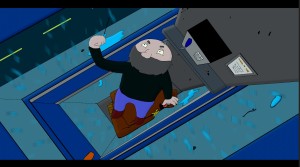
With his only home being a phone booth outside a liquor store, the arrogant Liam (Karl Spain) tries desperately to get help for his problems – but only finds more problems.
CH: How, if at all, did the pandemic affect the production process for season 2? What did you and your cast/production team do to overcome the challenges that came with working under those circumstances?
TQ: It changed everything, of course. After writing the scripts in summer 2019 I initially started doing tests for season 2 in about September 2019. While I was working full-time teaching filmmaking and working a retail job, on my day off I would still go to the local library and plug in there for the day and animate as much as I could.
My plan then was to just power through it and be done by January or February, but around late November I remember feeling worried that I wasn’t happy with anything I had created. I was frustrated that everything was taking so long and I started to wonder if I would ever finish it.
Then Christmas came and went. I promised myself in January of 2020 I would do more but then I got distracted by an Irish General Election, I ended up spending two weeks traveling and shooting a half hour documentary on that. While I was filming (the documentary, I kept thinking in the back of my head about this animation project that I was slowly realizing was actually a much bigger job than I initially thought. This documentary is available on my website for anyone who wants to see it.
Then when the pandemic did hit my teaching finished overnight, my retail job closed and I was suddenly at home every day. This is when the animation process really started in full. The layout process for all seven episodes was really done in this period from March to August. I worked another retail job from September to December and tried to do one shot a day but that still wasn’t enough to get the project over the line. I did spend a lot of this time emailing cast and bringing other people onboard.
At this stage I thought I was almost done but when I was let go again from that job, I returned to the animation full-time in January and February of 2021 and that was when it was really completed. I can see now, of course, it never would have gotten done, or at least not to the standard it is now, if it wasn’t for the pandemic. So while I had a hard and long 12 months, I feel I managed to pull something good out of it that I am really proud of.
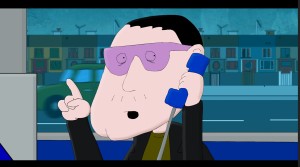
International rock legend Bono (voiced by Colman Hayes) turns his latest charitable effort towards the hopeless Liam (Karl Spain)…with disastrous results.
CH: Besides the show’s expanded cast, retooled narrative approach and improved animation design, what else do you feel sets season 2 of Poxy Bleedin Shop apart from its first season?
TQ: Those would be the principal things but taken together, those things make the product a lot more of a commercial vehicle and a more enjoyable experience for the audience than the previous season was. I also tried to make the project funny not just for me but for other people too.
Unlike series 1, which was created in somewhat of a vacuum throughout the production and post-production of series 2, I was always showing it to people and looking for advice and opinions, I’m lucky I am surrounded by a lot of very creative people who are not afraid of telling me what they think of my work. I am pretty open-minded and was able to take their opinion on board and it was all for the benefit of the project.
CH: In terms of adult-oriented cartoons and other edgy comedies, what other shows would you compare yours to?
TQ: I love the satirical humor of South Park even though our series isn’t satirical at all. I love Bob’s Burgers for the family and community aspect of that series and The Big Lez Show (an Australian animated YouTube series) for it being independently made like we are. I like the surrealism of The Big Lez Show too. One of the fight scenes in that show actually inspired a scene in our series.
The Big Lez Show is very much a personal expression of the world and I think our series is too. I also enjoyed Kim’s Convenience on Netflix, which isn’t an (animated series) but wasn’t a million miles away from what I was attempting to do in terms of telling the store of a small, underrepresented community through a local shop. I was sad to see that finish recently.
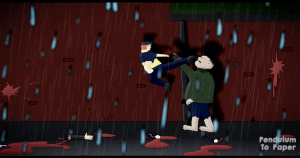
Hard-nosed guard Foley (voiced by Aidan J. Collins) lays down the law to a back alley thug in POXY BLEEDIN SHOP.
CH: What, in your opinion, makes Poxy Bleedin Shop unique among adult cartoon series?
TQ: It’s unique because it’s Irish. It’s topical and it’s not nostalgic at all. It deals with serious issues (such as drugs, alcoholism and homelessness) which is especially such a major issue in Ireland and (in the) past, several governments have shown little to no interest in solving (those problems).
By making one of the major characters a homeless man with real character and a storyline you can invest in, I hope people will think twice when they walk past homeless people on the street. He is also based on a real person who used to come into the shop. It’s also unique because it’s somewhat autobiographical as I really did work in an off-license, and while I have taken creative liberties with the story, I have tried to remain true to the characters of that world.
CH: Finally, what are your hopes for the show’s success?
TQ: Firstly, I just hope people see it and share it and spread the word about it. Whether it finds a cult audience or a mainstream audience or anyone at all it’ll be interesting to see. I think the project has commercial appeal, the storyline is contemporary and has something to say. The animation and technical aspects are up to a high enough standard. It’s funny and the cast we hired are commercial and very well known in Ireland. I think if we were supported and given a chance we could expand the series and make something that is both sustainable from a business point of view, and also artistic from a creative point of view.
NOTE: Quain says that all episodes of Poxy Bleedin Shop are closed-captioned on YouTube.
Watch the season 2 premiere of Poxy Bleedin Shop on YouTube:
https://www.youtube.com/watch?v=jfsYDf3h_9U
On Facebook: https://www.facebook.com/poxyshopseries/
On Twitter: https://twitter.com/poxybleedinshop
Find out more about Thomas Quain and his work on his official web site:
https://www.thomasquainfilm.com/

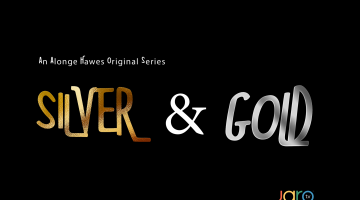



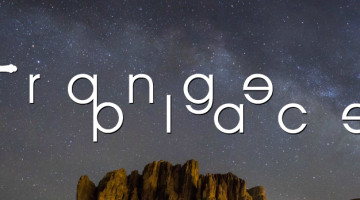

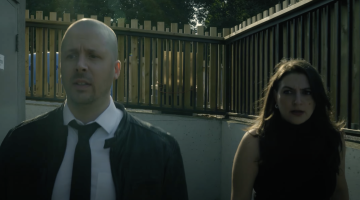
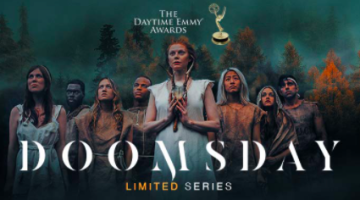

No Comment